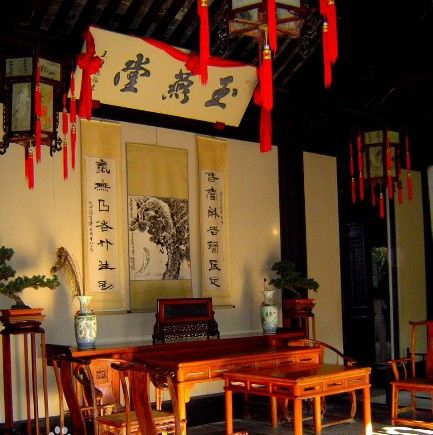Zhouzhuang: China's first water-town
(chinadaily.com.cn)

Zhang's House
Zhang's House is a well-preserved residential compound in Zhouzhuang dating back to the Ming Dynasty (1368-1644) and a key cultural relic protection site of Jiangsu.
The house, with a history of over 500 years, was built by the descendant of Xu Mengqing, who was a younger brother of Xu Da, the Zhongshan King in the Ming Dynasty. In the early years of the Qing Dynasty (1644-1911), the house was sold to the Zhang family due to Xu's decline, and its name was changed into Zhang's House.
The house covers an area of over 1,800 square meters with over 60 rooms. It has six rows (or jin in Chinese, which means any of the several rows of houses within an old-style residential compound) with a private backyard garden.
The first row is the hallway, which is mainly for decoration. The Zhang family decorated it with lanterns and streamers when happy events happened.
The second row is the tea room. On the left is a large sedan chair carried by eight people. Under the influence of hierarchy in feudal society, distinguished guests were entertained in the main hall, while boatmen and bearers could only wait for orders in the tea room.
The third row is the main hall, where the Zhang family held weddings and funerals and received important guests. Its furniture highlights simple, linear, exquisite and elegant styles. In the Ming Dynasty, thresholds symbolized official positions. According to historical records, the owner's official position is equivalent to a vice-governor, so the thresholds in the house are quite high.
The fourth row is the lobby building with two floors. The second floor is where female members live. The first floor is a place where the hostess can entertain female guests. The furniture here is arranged with symmetrical structure. The long table in the lobby has exquisite workmanship with carving decoration. On the two sides of the table are displayed vases (ping in Chinese) and mirrors (jing in Chinese), which translates to enjoying the silence (pingjing in Chinese).
The fifth row is the room for enjoying music and playing chess. In ancient times, girls in rich families stayed indoors all the time. Therefore, this room was used by them to play musical instruments and chess, like today’s karaoke.
The sixth row is a study by the river, which is well lighted. Its quiet and elegant environment is good for reading and working.
There are two pictures of Jiang Zemin, former Chinese president, inspecting Zhang's House on June 8, 2001, on the wall of the corridor to the backyard garden.
Walk on and you can find a narrow river, called Zhujing, which is linked with the outside lakes. Along the river, there are bridges, streams and households. This design has two functions: shipping daily supplies and escaping danger.
Behind it is the backyard garden, with a family hall for worshipping the Buddha. Amitabha, Avalokitesvara and Mahasthamaprapta are enshrined and worshipped inside. On the side is the home school for kids to study.
In the east of the lobby is an alley, equivalent to today's exit passageway. In feudal society, the gate was opened only for honored guests. This alley was used for family members in ordinary times.
KUNSHAN IN MY EYE
- A novel venue to celebrate the art of Kunqu
Kunqu artist Zhang Jun racked up a new career achievement during his performance at the Modern Drama Valley festival at the Mercedes-Benz Arena on May 18, performing in a venue that is several times larger than what he is used to.
- US travel companies discover Suzhou
39 American travel professionals were given a two-day tour of the 2,500-year-old city from Sept 13 to 14, including visits to famous sights like Tiger Hill and Shantang Street, as well as chances to experience traditional Chinese art.


